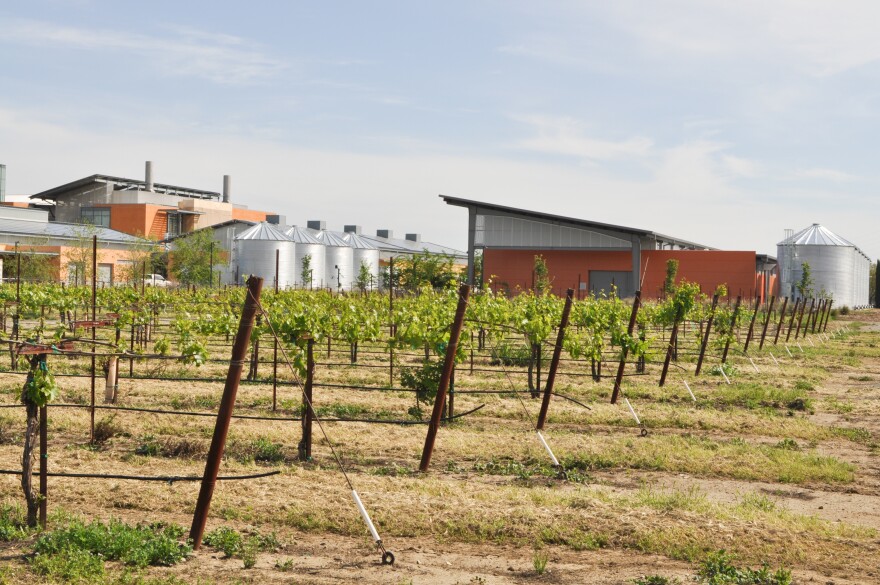In Napa, Calif., a company called fills and dispenses reusable wine kegs, which are used by restaurants and bars for serving wine on draft. Every month, the company rinses and refills about 10,000 of the stainless steel casks, each of which eliminates the need for 26 clunky wine bottles.
This is a small win for the environment, since glass bottles are heavy and require energy to ship.
But as the West Coast's drought began setting records two years ago, Free Flow's cofounder, Jordan Kivelstadt, started thinking less about his carbon footprint and more about water. His facility, launched in 2009, uses 5,000 gallons a day to clean and sterilize its casks.
So, about six months ago, Kivelstadt installed an onsite water treatment system that recaptures 99 percent of his rinse water and has cut Free Flow's water use down to almost nothing. Kivelstadt says setting up and installing the system cost a half-million dollars — a very considerable investment. However, he estimates the system will have paid for itself through reduced water bills in two to three years.
The weeklong water treatment process at Free Flow works a lot like that of a sewage treatment plant and produces water pure enough to drink, says Kivelstadt. The system loses just a slight fraction of the water to evaporation.
"We estimate we're saving about a million and a half gallons of water a year thanks to our recovery system," says Kivelstadt.

Pressed to make improvements in the way they use water, others in the wine industry are thinking just as hard about how to reduce and conserve. At the , a research winery will be upgrading its existing rainwater capture system this winter. The new setup should provide all the water for the winery's needs, according to David Block, chairman of the UC Davis viticulture and oenology department. Block says there are additional plans to install a water recycling system, similar in concept to the one at Free Flow.
The winery's goal is to dramatically cut the amount of water it must use for cleaning by using the same water, over and over again. The hope is also that commercial wineries, not to mention breweries and other producers, will adopt the technology.
Currently, says Block, most California wineries use somewhere between 2.5 and 6 gallons of water to make each gallon of wine — a ratio that does not include irrigation water and other pre-harvest needs. Big wineries, he says, are more efficient than little ones, since they make more wine per amount of surface area — and are able to clean that surface area using proportionately less water than a small winery would need.
The UC Davis research winery is a small facility. Still, the plans here are big.
"Our goal is to get down to a 1 to 1 ratio or less," Block says.
Few wineries have installed water treatment and recirculation systems. Still, many say they are doing their part by using their wastewater for irrigation purposes, which can relieve pressure on streams and groundwater reserves.
According to Allison Jordan, vice president of environmental affairs with the , an industry organization, slightly more than half of 391 wineries surveyed in 2012 reported using at least some of their wastewater for landscaping or vineyard irrigation.
In Australia, where a decade-long drought known as the "Big Dry" prompted a revolution both in cities and on farms in how water is used, most winery wastewater eventually is piped onto agricultural land, according to Robin Nettlebeck, chief viticulturist with , in South Australia, who corresponded with The Salt by email.
But how helpful, really, is the use of winery wastewater for irrigation? A great deal of this wastewater is produced after harvest, just when grapevines may be entering their winter dormancy. They need little, if any, water at this point.

Many vineyards, in fact, are dry-farmed — that is, given no water except for rainfall. Wastewater might not benefit these vineyards at all.
UC Davis researcher Maya Buelow says irrigating with wastewater is usually only an effective method if it is coupled with long-term storage that allows farmers to save the water until spring and early summer — the time of year when irrigated vineyards most need water.
Buelow, who feels there is plenty of room for making conservation gains via wastewater irrigation, feels a social stigma has inhibited the spread of this water-saving technique on American soil.
"It's misunderstood by a lot of people, who might say, 'Eww — wastewater,' " says Buelow. She points out that wastewater, in this context, does not include sewage water — just water that flows into floor drains and sinks.
That's not to say there aren't some valid concerns to consider. Winery wastewater, even after it has been treated in onsite tanks or ponds, may contain salt residue left over from certain cleaning agents. This can be potentially problematic, causing harmful salt buildup in the soil and damaging vines.
But Buelow and several colleagues, by analyzing the wastewater and soil from 18 wineries, have found that, in most cases, treated winery effluent is safe for use in irrigating grapevines. In cases where chemical residues are high, changing the type of cleaning agent used can make all the difference. Her research resulted in two studies, recently published in the American Journal of Enology and Viticulture and the journal Agriculture Water Management.
In California, forecasts for longer, harsher droughts to come are likely to force wineries, as well as other industries, to rethink the sometimes wasteful ways in which they use water. At the UC Davis research winery, Block feels the innovations his department is making in water recapture, treatment and reuse could, by necessity, eventually become standard practice.
"In areas where groundwater reserves run out, they're going to have to do this," Block says.
Copyright 2020 NPR. To see more, visit https://www.npr.org. 9(MDAxNDQ2NDAxMDEyNzU2NzM2ODA3ZGI1ZA001))



